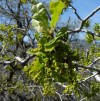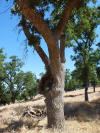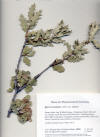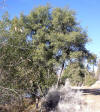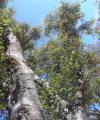|
Quercus
acutidens
|
Quercus agrifolia |
|
Quercus alvordiana
woodland (upper two photos) with occasional Q. douglasii
(lower photo). San Emigdio Range, Wind Wolves Preserve, CNPS
Field Trip I |
|
|
Quercus alvordiana S Sierra Nevada Mts., Kern Co., CA. East of Sand Canyon Rd leading to Upper Pine Tree Canyon, NNE of Middle Knob along a graded dirt road.. Large shrub or scraggly tree, semi-deciduous; leaves bluish green. 26 Apr 2010.
|
Quercus arizonica
|
Quercus cf. berberidifolia S Sierra Nevada, Kern Co., CA. East of Sand Canyon Rd, road to Upper Pine Tree Canyon, NNE of Middle Knob, ridge with a graded dirt road. Leaves deciduous, new leaves becoming coriaceous, shiny, yellowish green, spiny margins. Shrubs about 2 m tall observed in preceding month in flower without leaves (but could be Q. alvordiana since the plants were not tagged). 26 Apr 2010.
|
Quercus cf. berberidifolia S Sierra Nevada/Piute Mts., Kern Co. Vicinity of Stevenson Peak, Back Canyon, CA. Cattani Ranch. Deciduous shrubs, images from separate plants exhibiting hybrid features of Q.wislizeni and Q. douglasii. 5 May 2010. |
|
|
Quercus berberidifolia
|
Quercus chrysolepis
|
Quercus chrysolepis
|
Quercus cornelius-muelleri |
|
Quercus douglasii Woodland Alliance Kern
River Canyon, CA
|
Quercus douglasii Mill Creek Trail,
|
Quercus douglasii Mill Creek Trail,
|
Quercus durata
|
|
|
Quercus durata
|
Quercus durata |
Quercus emoryi
|
Quercus
gambelii
|
|
|
Quercus garryana var.
garryana
|
Quercus garryana var.
garryana
|
  Quercus garryana var.
garryana
|
Quercus garryana var.
breweri |
|
  Quercus garryana var.
semota
|
Quercus garryana var. garryana Greenhorn Mts., Munn Camp N of Hwy 155, CA. Oct 23. 2013
|
Quercus john-tuckeri |
Quercus john-tuckeri |
|
|
Quercus john-tuckeri
|
Quercus kelloggii
|
|
Quercus lobata
|
|
  Quercus
palmeri
|
Quercus
pungens
|
|
Quercus turbinella Arizona Desert. Gila Co.:
Dripping
|
|
|
Quercus vacciniifolia
|
Quercus welshii |
Quercus wislizeni |
  
Quercus wislizeni x john-tuckeri |
|
|
Quercus wislizeni
|
|
Quercus chrysolepis on left in both images (veins obscure on upper
surface) and Quercus wislizeni on right in both images (veins
conspicuous on upper surface, slightly raised).
|
Quercus wislizeni
|
|
|
Trees and Shrubs of Kern County (Dec 2012, Feb 2014) Quercus (oaks). Species of oaks are often segregated in keys by whether their acorns mature in one or two seasons. Unless you want to sit under the tree for a couple years to find out, it might help to use binoculars to see the acorns (if they are not on the lower branches). One needs to decide whether the acorns are on current season's growth, or on the second year growth. This may be determined by the position of the bud scars of the current season relative to that of the acorn; acorns above the scars are on new growth, those below the scars are on second year growth. On the other hand, if there is no acorn crop, then one has to key both ways. An alternative key is provided that avoids this character. Key to species of Quercus (oaks). Some species are tentative as they are also considered hybrids. The technical name for fruit of the oak is glans however, in the literature it is called an acorn. This includes the pericarpium, referred to as “nut”, and its cup. Both parts may fall together or separately, which collectively constitute fruit, because the cup enlarges following fertilization.
1. Leaves more lobed
than toothed, usually
deciduous,
often turning yellow, 2. Lobes with terminal hair-like bristles; lower montane forests............................. 3 3. Leaves deciduous; common tree................... .................. Quercus kelloggii 3. Leaves persistent; frequent tree, putative hybrid............ Quercus × morehus 2. Lobes without hair-like bristles....................................................................... 4
4.
Shrubs; leaves
thick, leathery, the older leaves shiny green on
4.Trees; leaves thin, dull to glistening on upper surface;
generally
5. Lobes shallow, < halfway to center vein
(midrib), or
5. Lobes extending halfway or more to midrib,
5a. Some of the main lobes of leaves with shallow
1. Leaves more toothed
than lobed, margins often spiny, especially in youth, usually
6.
Upper (adaxial) surface of leaves shiny dark green with prominent
6.
Upper surface of leaves shiny to dull green, not prominently reticulate
7.
Leaves plane (flat) to rarely slightly cusped along margins, usually
7.
Leaves contorted, rounded and slightly heart-shaped at base 8. Leaves contorted or bent upwards, especially along midrib........................... 9
8. Leave mostly plane or curved downwards across the
surface,
9. Leaves pale grayish to golden green below, often with
short glandular
9. Leaves dark green to bluish green or glaucous, hairs if
present not
10. Leaves deciduous or
semi-deciduous; common in Southern Sierra 10. Leaves persistent ........................................................................... 11
11. Leaves heart-shaped near base (cordate); eastern
Mojave Desert 11. Leaves rounded or sharply angled to base......................................... 12
12.
Leaves dull green and stellate hairy on both surfaces;
12.
Leaves green and bald above, lower surface glaucous
13.
Lateral leaf veins impressed into the upper surface,
13A.
Trees; lateral (pinnate) veins 4 pairs; rare in Kern Co.,
13A. Shrubs;
lateral (pinnate) veins 4–8 pairs; rare in Kern Co.,
13.
Lateral veins obscure to plainly evident, nearly flush or raised,
14. Densely leafy,
hedge-like or mound-like shrubs, wider than tall, much
14. Shrubs or trees
generally taller than wide, stem usually visible;
15.
Usually trees, occasionally shrubs, to 25 m; leaves whitish or
15.
Usually shrubs 1–2 (-4) m; leaves light green and waxy
Quercus agrifolia Nee 1801. Coast live oak. Evergreen trees developing massive trunks with age, bark light gray to pale brown; leaves alternate, curved downwards (convex) across the upper (adaxial) surface especially near margins, with conspicuous lateral veins in 3–5 pairs that are impressed into the upper surface and raised on lower (abaxial) surface, toothed to entire along margins. Fruit: glans (acorns) with narrow conical pericarpium, tapering to a point, cupule covering 1/4 to 1/3 of the pericarpium, with imbricate flattened scales. A characteristics species of the coastal ranges, canyon slopes, ravines, streamside terraces, and swales below 4,000 ft; Humboldt Co. to San Pedro Mártir, Baja California. Coast live oak woodland recognized in MCV2 when >50% relative cover in tree canopy. Type from Monterey, CA. Kern Co.: Temblor Range—Bill Little Spring in the upper Chico Martinez Canyon, and a few scattered trees in swales on Drake Ridge (Twisselmann), 500–900 m (CCH). Quercus alvordiana Eastwood 1905. Deciduous or semi-deciduous trees or shrubs with crooked and twisted trunks, twisted branches, and contorted leaves. Abrams recognized it as a species occurring from San Carlos Range to Baja California, citing the type from San Emigdio Canyon, Kern Co., CA. Interpretation as a distinct species, however, has been problematic. Tucker (1952) concluded that it is largely a hybrid taxon “between Q. turbinella var. californica and Q. douglasii;” the former corresponds to Q. john-tuckeri, maintained by Tucker in JM1 and JM2, recognized to occur mainly in Tehachapi Mts., Temblor and San Emigdio ranges. Twisselmann apparently implied that it is a species, stating that it often forms “a specialized woodland [see above photos from Windwolves Preserver] and sometimes grows in dense thickets.” [see above photos from below Tecuya Ridge]. Also observed as a dominant semi-deciduous tree in the Sierra Nevada foothills on Emerald Mt. near Stevenson Peak, and occasionally elsewhere as a completely deciduous shrub such as near Cache Peak. Because plants often appear to reproduce by seed their tree habit and semi-deciduous character traits, and because the plants constitute a dominant element of the vegetation, this would seem to justify species status. This is further supported by oak species having evolved by hybridization, even though hybrid swarms regarded by Tucker (1952) were considered Q. × alvordiana. “Intergrading populations have been noted in the Inner South Coast Ranges as far north as central San Benito County, on the west side of the Salinas watershed in Monterey County, in the Tehachapi Range, and elsewhere” (Tucker 1952). Nixon & Muller (FNA) does not mention the species or hybrid. Quercus berberidifolia Liebmann 1854 [Quercus dumosa Nuttall 1842 misapplied]. California scrub oak. An evergreen densely branched, shrub, or small tree; branches stiff, leaves shallowly lobed with the lobes terminating in a blunt to sharp point or spine, green and somewhat shiny above, duller or grayish below with branched (stellate) hairs, generally truncated and three lobed near apex with the middle lobe on some leaves longer and triangular. A common chaparral species below 6,000 ft in the Coast Ranges and southern Sierra Nevada to central Kern County, often occurring with chamise (Adenostoma fasciculatum) in the southern Coast Ranges (MCV2). Type from California without further detail as to specific location (Coulter 661 K, IT, MO); the collection number also the same as that for Quercus beccariana Bentham as reported in Tropicos. Kern Co.: Occasional in the chaparral in the Tehachapi Mountains [Tejon Ranch, Fireguard Rd, 1 mi from Oso Cyn Rd, 1249 m, 16 Apr 1962] and the San Emigdio Range [San Emigdio Camp, Reyes Crk, H & M. Dearing, 6 Dec1936; 12 miles above the San Emigdio Ranch Houses, 2,800 ft, C. N. Wolf, 16 Sep 1931; (Twisselmann)], 854–1,890 m (CCH, 3 of 6 records), also Kern Cuddy Valley, Mt. Pinos Region, 6,200 ft, L. C. Wheeler, 25 Oct 1931; Mt. Pinos, Lewis, 3 May 1947, and Kern River Canyon, R. Perkins, 23 Apr 1937. The California scrub oak in Kern Co. and elsewhere in California has been previously included under a broader concept of Quercus dumosa Nuttall (Nixon & Muller in FNA, 1997). Quercus dumosa has since been interpreted as restricted to coastal scrub below 1,000 ft, usually within view of the ocean, the type from near Santa Barbara. As a result of real estate developments, it has become a rare species in California, currently best preserved in Torrey State Park in San Diego Co. It also occurs further south along the coast into Baja California (Nixon 2002). Nixon and Muller in FNA (1997) and Nixon (2002) indicated California scrub oak is mainly a Coast Range species that extends across the Transverse Ranges and south along the Peninsular Ranges into Baja California (SEINet), whereas the range given in JM1&2 by Tucker includes the Sierra Nevada foothills. As stated by Nixon and Muller, “Quercus berberidifolia is the most common scrub oak of central and southern California, mostly at middle elevations in the Coast Ranges.” Scrub oak chaparral recognized in MCV2 when >60% relative cover in the shrub canopy, primarily on north-facing slopes, and shown to occur in Kern County despite the relative reported infrequent occurrence by Twisselmann and relatively few specimens in CCH for Kern County. California scrub oak apparently hybridizes with John-Tucker oak on mountains above Ventura and on the north slopes of the Tehachapi Mountains, and also with other species of oaks outside Kern County (Nixon & Muller in FNA). Just north of the town of Tehachapi in southern Sierra Nevada are deciduous or semi-deciduous shrubs as shown above. Diagnostic features of Q. berberidifolia include 7–8 star-rayed hairs on the lower leaf surface, a relatively flat waxy upper leaf surface, a wide leaf base, and a barrel-shaped acorn (Nixon & Muller, FNA 1997). Quercus chrysolepis Liebmann 1854. Canyon live oak. Usually a tree to 20+ m; twigs golden brown; leaves with veins more conspicuous above (adaxial) than below, often green above and golden hairy below, broad with parallel margins for most of the length, or tapering from base, 3–6× longer than wide, or broadly elliptical and 2–3× longer than wide, generally 2.0–7.0 cm long, thick, leathery, rounded at base to petiole, secondary veins 12 or more pairs, often slightly revolute along margins, entire to toothed—especially young leaves; acorns solitary or paired, or rarely in 3s or 4s; cup saucer-shaped, often appearing swollen, tuberculate; pericarpium widest just above base, 1.5–3.0 cm. Flowering in spring, occasionally in fall. Usually in canyons and moist slopes, or ridges up to 9,000 ft; Oregon to Nevada, Arizona, New Mexico to Chihuahua, Sonora and California to Sierra San Borja in Baja California. Canyon live oak forest recognized in MCV2 when >50% relative cover in tree canopy. A chaparral type alliance is also recognized but this occurs outside Kern Co. Type from California. Kern Co.: Generally wetter or shadier canyons in the montane conifer forest region, 731–2,529 m (CCH). Twisselmann commented that it “is found “in deep canyons in the Tehachapi Mountains to a lesser extent elsewhere; it tends to replace Douglas oak and become the dominant tree of a plant community more mesic than that of the surrounding slopes but not markedly enough to warrant formal recognition as a plant association.” . Like most species of oaks, leaves of canyon live oak vary from elliptical to sword-shaped, and may bear teeth along the margins, or margins may be entirely smooth and abruptly recurved (revolute). The main distinguishing features are in the difference in color between the upper and lower leaf surfaces, bright green above and paler beneath— varying from grayish white to rusty, and in the acorns that have short bulging cups. Quercus douglasii Hooker & Arnott 1841. Douglas oak, blue oak. Tree to 20 m; leaves deciduous, broad elliptical (egg-shaped) 3–4× longer than wide, broadly rounded to apex, entire to shallowly lobed, bluish green. Common in foothill savanna around the Great Valley with ghost pine, juniper, buckeye, valley oak and other trees and shrubs, and in the southern Coast Ranges. Blue oak woodland recognized in MCV2 when >50% relative cover in the tree canopy. Type from California without specific location. Kern Co.: “The common tree of the cismontane foothills and the Temblor Range that forms a distinctive woodland at the middle elevations, where it usually grows with digger pine (Pinus sabiniana). Douglas oak is also occasional east of the crest of the mountains, especially in the canyons of the Tehachapi Range and the other desert-facing canyons north to Jawbone Canyon and the west side of Kelso Valley” (Twisselmann), 487–1,585 m (CCH). Douglas oak was a main source of firewood for early inhabitants. Acorns were used as a coffee substitute, while the insect galls have been toys for pioneer children (Twisselmann). Quercus durata Jepson 1909. Leather oak. Evergreen shrubs to 2.5 m; leaves short to long elliptical curved downwards (convex) across the upper (adaxial) surface especially near margins but not uniformly, somewhat undulating, with lateral veins in 4–8 pairs impressed into the upper surface raised on lower (abaxial) surface (at least in var. durata), toothed to entire along margins. Fruit: glans (acorns) with subcylindrical pericarpium, round tapered to a short pointed apex, cupule covering 1/4 to 1/3 of the pericarpium, with tubercled scales. Often on serpentine, California chaparral in Coast Ranges south to Ventura County along the outer ranges, and nearly to the northwest corner of Kern County in the inner ranges, also in the foothill woodlands of northern Sierra Nevada, and in the San Gabriel and San Bernardino Mts. Leather oak chaparral recognized in MCV2 when >50% relative cover in the shrub canopy. Type from San Luis Obispo Co., CA. Kern Co.: Known only from along the Kern River in Kernville (Spjut obs. & photo, Dec 31/Jan 1, 2006-07, image shown above). The Kern County report is notably disjunct from the other occurrences in California. The location along the Kern River was within the understory of a interior live oak (Quercus wislizeni) forest accompanied by scattered trees of the Utah juniper (Juniperus osteosperma), which also is not known from Kern County. As noted under Juniperus californica, a columnar form, f. lutheyana J. T. Howell & Twisselmann (Four Seasons 2(4): 16 1968), was described from near Kernville. The interior live oak trees seem to be some of the largest in the County (only var. frutescens recognized in Twisselmann); see images above. In much of the literature, and on the Internet, leather oak is confused with California scrub oak (Quercus berberidifolia). California scrub oak is recognized by the flat surface leaves with spiny margins mainly in the upper third. Quercus garryana Douglas 1839 var. semota Jepson 1909. Shin oak. Deciduous shrub with leaves often lobed and toothed, but occasionally entire; upper leaf surface hairy when young, often glossy when old. Southern Oregon, Klamath Mts., southern Cascades, western Sierra Nevada to Tehachapi Mountains. Brewer oak scrub is recognized in MCV2 when >50% relative cover in the shrub layer (includes shin oak). Type from Kaweah Basin, southern Sierra Nevada. Reported by Twisselmann as Q. garryana var. breweri, which is now considered a separate variety found in northern California. Kern Co.: “Common in dense and sometimes extensive thickets just below the yellow pine forest from Glennville to the slopes northeast of Lebec. In the Tehachapi Mountains it sometimes forms impenetrable thickets covering hundreds of acres” (Twisselmann), 914–1,829 m (CCH). Quercus garryana var. fruticosa might be recognized in Kern County based on the length and number of branched hairs on the undersurface of the leaves; “4–6, 0.25–0.5 mm.” This apparently occurs in the Sierra Nevada region of the County in contrast to var. semota with hairs “6–8, < 0.3 mm” found in the Tehachapi Mountains (CCH). Variety garryana is tentatively recognized in Kern County based on the tree habit; the leaf hairs also do not agree with the other varieties. It occurs on Breckenridge Mt. Quercus john-tuckeri Nixon & Muller 1994 [Q. turbinella Greene 1889 ssp. californica J.M. Tucker 1952]. Tucker's oak. Evergreen or semi-deciduous shrub or tree to 5 m, often with a broader much-branched hemispherical crown; bark scaly, brown to gray; twigs hairy; leaves twisted, leathery and wavy along margins, elliptic to wider above the mid region, 1–2× longer than wide, 1–4 cm, cut-off (truncate) or narrowed to base, shallowly lobed to toothed with spine tips. Common in the transitional vegetation between the desert or valley woodland and montane forests of southern California; chaparral slopes and pinyon-juniper woodlands, 3,000–6,000 ft, interior Coast Ranges, Tehachapi Mts. and Sierra foothills to northern Sacramento Valley. Type from San Luis Obispo Co., ~2 miles northeast of summit of Caliente Mountain. Tucker oak chaparral recognized in MCV2 when >50% relative cover in the shrub canopy. Kern Co.: A “common shrubby oak, often becoming a picturesque small tree, of the arid Douglas oak woodland in the San Emigdio and Temblor ranges, southwest to the north flank of Mt. Abel, occasionally northeast through the Piute Mountains to Erskine Canyon” (Twisselmann as Quercus turbinella Greene ssp. californica Tucker), 548–1,920 m. Quercus turbinella is found mainly in the eastern California desert to Utah and western Texas. Quercus kelloggii Newberry 1859. Kellogg's oak or California black oak. Deciduous tree easily identified by the lobed leaves that have fine bristles at the ends, leaves turning red to orange in the fall. Largely a California montane species extending north to western central Oregon, woodlands, chaparral and open conifer forests, 1,000–8,000 ft. California black oak forest recognized in MCV2 when >50% relative cover in over-story and conifers are not conspicuous, or >30% relative cover in the overstory and ponderosa pine may equally dominate. Type from mountains near San Francisco and between Fort Redding and Lassen Butte, CA. Kern Co.: Forming a woodland just below the pine forest belt (Twisselmann), mostly between 1,000 and 2,200 m, Greenhorn Range, Piute Mt., Breckenridge Mt., Tehachapi Mts., and Mt. Pinos in Transverse Ranges (CCH). Quercus lobata Nee 1801. Valley oak. Deciduous tree with deeply furrowed bark and deeply lobed leaves, the lobes often broad and 5 per side; acorns with conical “nuts.” A California species that is common about foothills of the Great Valley. Valley oak woodland recognized in MCV2 when >50% cover in the tree canopy or >30% relative cover when coastal live oak and arroyo willow are present. Kern Co.: 100–1,800 m, Greenhorn Range, Tehachapi Mts., and Transverse Ranges (CCH). “Common in the foothills of the mountains forming “park lands in the valleys around Glennville, in the Tehachapi Mountains, and at Lebec” (Twisselmann). “Occasional on the edge of the desert in the northwest end of Antelope Valley and on the broad slopes of the southeastern Tehachapi Mountains north to Cameron Canyon (Twisselmann). Occurs in a singular association with Jeffrey pines on the ridges southwest of the summit of Tejon Pass at an elevation of 5,600 feet” (Twisselmann). Quercus × morehus Kellogg. Oracle oak. “hybrid between Q. kelloggii and Q. wislizeni.” Widespread and occasional in lower montane forests of California. Kern Co.: Mostly Sierra Nevada region, Owens Peak, Greenhorn Range, Breckenridge Mt., to Mt. Pinos, 914–2209 m (CCH). Quercus palmeri Englemann 1880. Palmer oak. Evergreen divaricately branched shrub or small tree, to 4 m tall and 9 m wide; twigs rigid, reddish brown; leaves contorted, ±round, 2–3 (-5 ) cm, spiny, with 5–8 pairs of lateral veins, the lower pairs at right angles to recurved, margins usually spiny, dark green above, glaucous and often golden glandular hairy below; acorn cups tuberculate, densely golden-hairy; pericarpium football to barrel shaped, 2–3 cm. Montane chaparral, scattered locations, California to Baja California, Arizona, 700–1,800 m. Type from east of San Diego, California. Kern Co.: Eastern Sierra Nevada, Short Canyon, in scattered colonies, 959–1189 m (CCH). A shrub <2 m high found in the Jurupa Hills of Riverside County is thought to be 13,000 years old. Quercus vacciniifolia Kellogg ex Curran 1869. Huckleberry oak. An evergreen shrub often wider than tall, not more than 2 m high; leaves thick, entire, green with conspicuous veins on upper surface, appearing with a bluish white like wax below. Chaparral along ridges and slopes in the montane region, 700–2,800 m; southern Oregon to California, generally west of the Cascades and north of the Transverse and South Coast Ranges, also Sierra Nevada where reported in CCH as far south as Tulare Co., 5.5 mi east of Quaking Aspen Guard Station (trail to needles lookout; saddle 0.25 mi w of lookout) at 7,900 ft. Type from the Klamath Mts. Huckleberry oak chaparral recognized in MCV2 when >30% relative cover in the shrub canopy. [Updated record: CCH—CA. Kern Co.: R. Lloyd (10 Jun 1959) 2.3 mi south of Cummings Valley Road on E. J. Cummings Ranch, 10 mi west of Tehachapi, 4,500 ft, identified Q. x alvoridana (CCH)]. Quercus wislizeni A. DeCandolle 1864. Interior live oak. Evergreen shrub or tree with grayish white smooth bark; leaves similar on both surfaces in color and in the absence of hairs, generally recognized by conspicuous tertiary veins on upper surface. Type from American River, CA. Kern Co.: A very common oak along the river and ravines draining into the Kern River in the Kern Canyon region of the County, occurring as a shrub or tree, 487–1,645 m, mostly southern Sierra Nevada (CCH). Twisselmann recognized only Q. wislizeni var. frutescens Engelmann: “A xerophytic shrub that is a common element of the chaparral from Mt. Abel northeast through the mountains to the Tulare County line. Small trees that grow at Hobo Hot Springs in Kern Canyon and near Keene vary toward the typical arboreal variety of the north and west,. However, they are probably only robust forms of the shrubby variety responding to very favorable soil, climatic, or moisture conditions. On Ednas Mountain, in the Greenhorn foothills south of Glennville, the shrubs also tend to be arboreal; these apparently are hybrids with Q. kelloggii.” Interior live oak chaparral in MCV2 includes both shrub and tree alliances; however, it is interesting that only the tree alliance is shown to occur through much of the central region of the county, corresponding evidently to Sierra Nevada, Tehachapi Mts., and Transverse Range portions of the county. Interior oak can be confused with canyon live oak; both occur together. The lack of a distinct color difference between the upper and lower leaf surfaces, along with veins being equally prominent on both surfaces, distinguishes the interior live oak. Surprisingly, there are fewer CCH collections of interior live oak from Kern County than canyon live oak. Quercus sp. (Q. wislizeni × john-tuckeri)? Colonial evergreen arborescent shrub or tree to 6 m; leaves contorted, ±round, 2–3 cm, spiny, conspicuously veiny on both surfaces, the veins raised, surfaces shiny; acorn cups honeycombed, gray; pericarpium not seen. Locally common above Bear Valley Springs, Tehachapi Mts., ~2,000 m. The conspicuous raised veins on the upper (adaxial) surface of the leaf is generally not seen in any species of oak. The hybrid status is inferred from the interior live oak generally recognized by leaves having conspicuous veins appearing flush on the adaxial surface, and by the twisted blades generally recognized as characteristic of the John Tucker oak.
Phytochemical References Pisarnitskii A.F., TIu Rubenia and A. O. Rytitskii. 2006. Hemicelluloses of oak wood extracted with aqueous-alcoholic media. Prikl. Biokhim. Mikrobiol. 42(5): 587–592. In Russian. “Hemicellulose fractions were isolated from ethanol extracts (40-90%) of oak wood. To determine the composition of these fractions, they were hydrolyzed, and the hydrolysis products in the form of trimethylsilyl derivatives were analyzed by GLC-MS. Depending on the content of ethanol, hemicelluloses of different composition were extracted from wood. In alcohols stored in a contact with oak wood and intended for manufacturing brandy and whisky, the content of hemicelluloses increased depending on storage duration. It is assumed that this makes drinks more full-bodied and imparts softness to them.” Saucier C., M. Jourdes, Y. Glories and S. Quideau. 2006. Extraction, detection, and quantification of flavano-ellagitannins and ethylvescalagin in a Bordeaux red wine aged in oak barrels. J. Agric. Food Chem. 54(19): 7349–7354. “An extraction procedure and an analytical method have been developed to detect and quantify for the first time a series of ellagitannin derivatives formed in wine during aging in oak barrels. The method involves a preliminary purification step on XAD7 HP resin followed by a second purification step on TSK 40 HW gel. The resulting extract is analyzed for compound identification and quantitative determination by high-performance liquid chromatography-electrospray ionization-mass spectrometry in single ion recording mode. Reference compounds, which are accessible through hemisynthesis from the oak C-glycosidic ellagitannin vescalagin, were used to build calibration curves, and chlorogenic acid was selected as an internal standard. This method enabled us to estimate the content of four flavano-ellagitannins and that of another newly identified wine polyphenol, beta-1-O-ethylvescalagin, in a Bordeaux red wine aged for 18 months in oak barrels. All five ellagitannin derivatives are derived from the nucleophilic substitution reaction of vescalagin with the grape flavan-3-ols catechin and epicatechin or ethanol.” |
||||
























